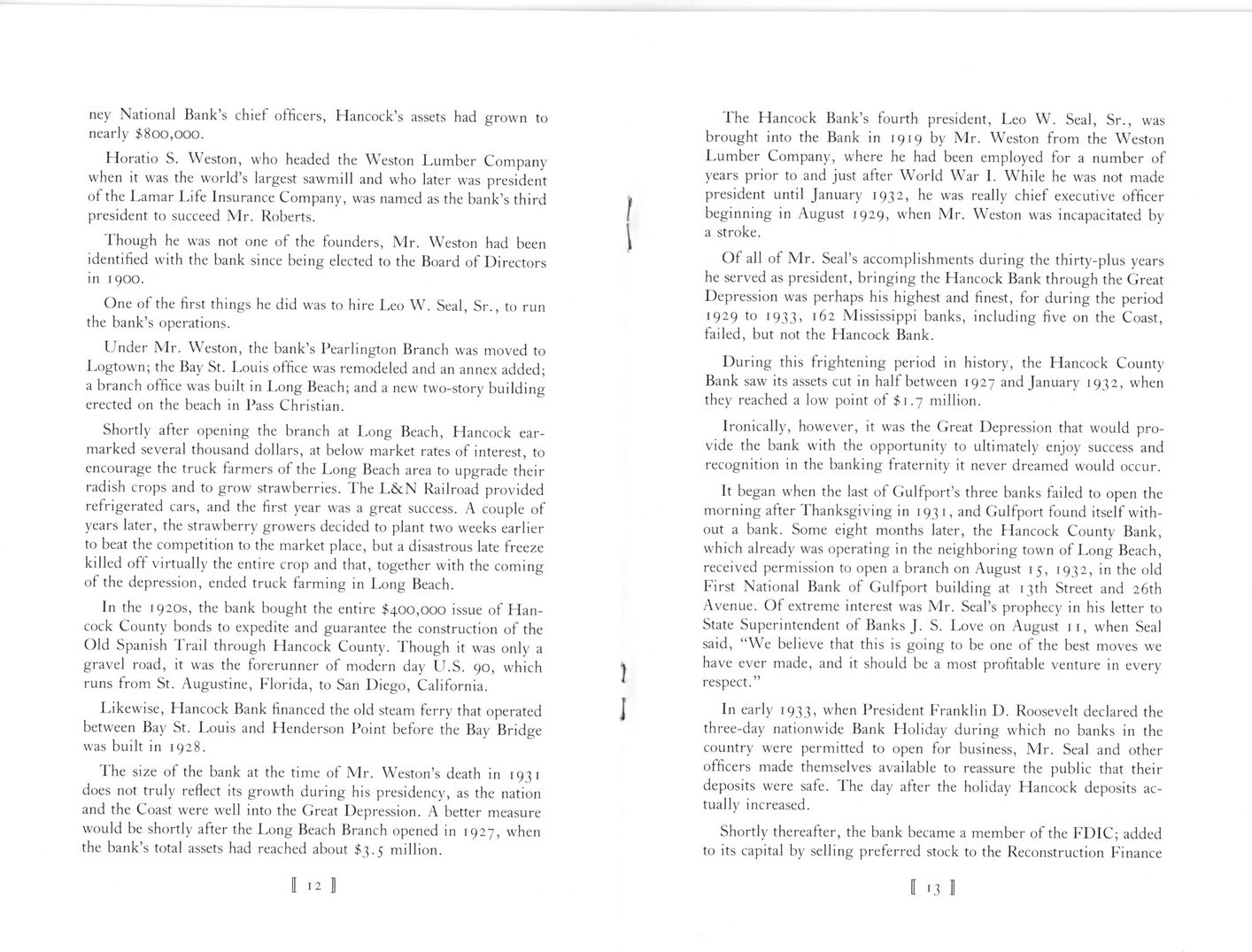This text was obtained via automated optical character recognition.
It has not been edited and may therefore contain several errors.
ney National Bank’s chief officers, Hancock’s assets had grown to nearly $800,000. Horatio S. Weston, who headed the Weston Lumber Company when it was the world’s largest sawmill and who later was president of the Lamar Life Insurance Company, was named as the bank’s third president to succeed Mr. Roberts. T hough he was not one of the founders, Mr. Weston had been identified with the bank since being elected to the Board of Directors in 1900. One of the first things he did was to hire Leo W. Seal, Sr., to run the bank’s operations. Under Mr. W7eston, the bank’s Pearlington Branch was moved to Logtown; the Bay St. Louis office was remodeled and an annex added; a branch office was built in Long Beach; and a new two-story building erected on the beach in Pass Christian. Shortly after opening the branch at Long Beach, Hancock earmarked several thousand dollars, at below market rates of interest, to encourage the truck farmers of the Long Beach area to upgrade their radish crops and to grow strawberries. The L&N Railroad provided refrigerated cars, and the first year was a great success. A couple of years later, the strawberry growers decided to plant two weeks earlier to beat the competition to the market place, but a disastrous late freeze killed off virtually the entire crop and that, together with the coming of the depression, ended truck farming in Long Beach. In the 1920s, the bank bought the entire $400,000 issue of Hancock County bonds to expedite and guarantee the construction of the Old Spanish Trail through Hancock County. Though it was only a gravel road, it was the forerunner of modern day U.S. 90, which runs from St. Augustine, Florida, to San Diego, California. Likewise, Hancock Bank financed the old steam ferry that operated between Bay St. Louis and Henderson Point before the Bay Bridge was built in 1928. T he size of the bank at the time of Mr. Weston’s death in 193 1 does not truly reflect its growth during his presidency, as the nation and the Coast were well into the Great Depression. A better measure would be shortly after the Long Beach Branch opened in 1927, when the bank’s total assets had reached about $3.5 million. The Hancock Bank’s fourth president, Leo W. Seal, Sr., was brought into the Bank in 1919 by Mr. Wreston from the Weston Lumber Company, where he had been employed for a number of years prior to and just after WTorld WTar I. Wrhile he was not made president until January 1932, he was really chief executive officer beginning in August 1929, when Mr. Weston was incapacitated by a stroke. Of all of Mr. Seal’s accomplishments during the thirty-plus years he served as president, bringing the Hancock Bank through the Great Depression was perhaps his highest and finest, for during the period 1929 to 1933, 162 Mississippi banks, including five on the Coast, failed, but not the Hancock Bank. During this frightening period in history, the Hancock County Bank saw its assets cut in half between 1927 and January 1932, when they reached a low point of $1.7 million. Ironically, however, it was the Great Depression that would provide the bank with the opportunity to ultimately enjoy success and recognition in the banking fraternity it never dreamed would occur. It began when the last of Gulfport’s three banks failed to open the morning after T hanksgiving in 193 1, and Gulfport found itself without a bank. Some eight months later, the Hancock County Bank, which already was operating in the neighboring town of Long Beach, received permission to open a branch on August 15, 1932, in the old First National Bank of Gulfport building at 13th Street and 26th Avenue. Of extreme interest was Mr. Seal’s prophecy in his letter to State Superintendent of Banks J. S. Love on August 11, when Seal said, “We believe that this is going to be one of the best moves we have ever made, and it should be a most profitable venture in every respect.” In early 1933, when President Franklin D. Roosevelt declared the three-day nationwide Bank Holiday during which no banks in the country w'ere permitted to open for business, Mr. Seal and other officers made themselves available to reassure the public that their deposits were safe. The day after the holiday Hancock deposits actually increased. Shortly thereafter, the bank became a member of the FDIC; added to its capital by selling preferred stock to the Reconstruction Finance

Hancock Bank Leo-Seal-Leading-The-Way-(1987)-07